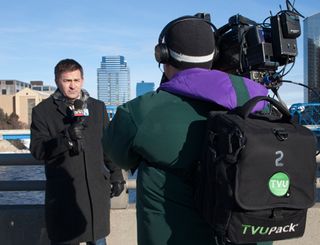At Stations, ENG Takes on Starring Role

Related: Local News: First, Live And More Automated Than Ever
Electronic news gathering was turned on its head several years ago when the launch of cellular bonding technologies allowed stations to greatly increase the amount of news they produce—a relatively low-cost way to transmit video over cellular networks will do that. But as those technologies now go mainstream and lead to widespread adoption in the news business, it’s opening up new opportunities to share content and create hybrid ENG products offering much greater reliability.
In some cases that has produced a shift in ENG technologies away from satellite and microwave to greater use of cellular bonding technologies, which take multiple signals from cellular providers and bond them to create greater bandwidth, or cameras with builtin Internet connectivity to transmit video back to the studio.
The proliferation of cellular bonded technologies were everywhere at this year’s World Cup in Brazil. Ken Zamkow, VP of marketing for the Americas at LiveU says that they had over 200 backpacks deployed at the games, up from under 40 in 2012, and they sent back over 2,600 hours amounting to about 40 terabytes of data. “It has gone from being something of a novelty to being one of the most popular ways to provide live shots from the field,” he says.
Meanwhile JVC, Panasonic, Sony and Canon have all begun offering cameras with IP connectivity. “In many cases the cameras can send back live video using an LTE modem in HD that looks as good as a news van for a fraction of the cost,” says Dave Walton, assistant VP of marketing and communications at JVC Professional Products, which has seen wide adoption of its IP-connected cameras.
Canon technical advisor Chuck Westfall doesn’t see the cameras replacing other ENG devices but says the “built-in IP connectivity… offered in the XF205 provides a much lower cost alternative” to other options.
Another major shift comes with the size and portability of these units. Zamkow notes that their newest LU500 unit is half the size and one-fifth the weight of the previous product but has substantially improved performance with high bit rates and more stable connections.
Broadcasting & Cable Newsletter
The smarter way to stay on top of broadcasting and cable industry. Sign up below
The major providers have also been rolling out apps that provide additional flexibility and features. Dejero, for example, offers mobile phone and laptop apps so “you can shoot an interview on your cellphone and then edit and go live from a laptop,” says Bill Nardi, VP of broadcast integration at Dejero.
ENG Goes Hybrid
Dejero and others are also forging alliances so that their cellular bonding technologies are being combined with other ENG tools.
As part of a partnership with Vislink, TVU, for example, has added Vislink’s integrated hybrid microwave IP technology to the new TVUPack 8200, explains Eric Chang, VP of marketing at TVU. “It means we can aggregate connections from cellular, satellite and now microwave to provide additional bandwidth and quality,” he says.
This connectivity is also encouraging the development of distributed production systems that enable station staff to work remotely to produce finished stories via the cloud. John Studdert, VP of sales and marketing at Sony Professional Solutions of America, notes the Sony Ci cloud-based video production platform not only provides journalists and producers with better tools and abilities to share content directly from cameras, it also significantly streamlines workflows.
Users can, for example, share and work on proxy files both in the field and at the station. That saves bandwidth and time because they can send the completed story, rather than the raw footage, back to the station.
“It is not common now, but we think it is a big part of the future because of the amount of people it can help you put on the street as newsgatherers,” he says.
